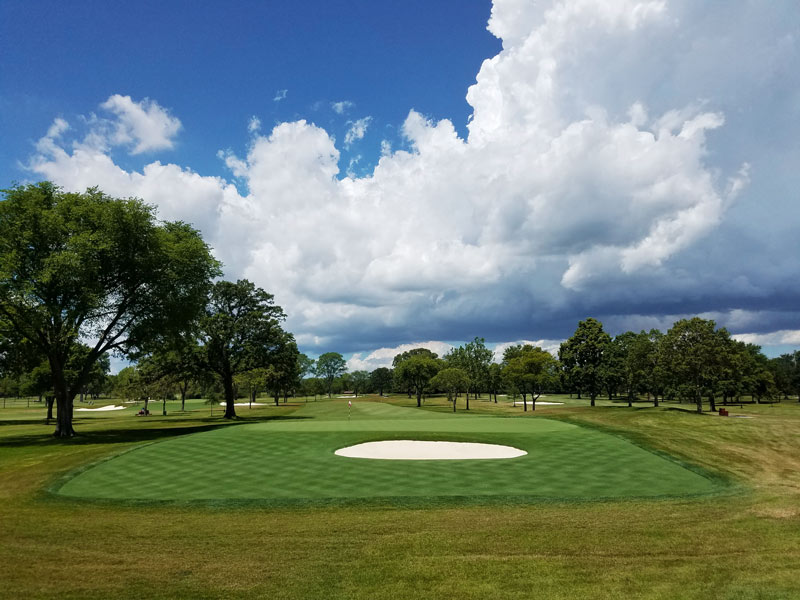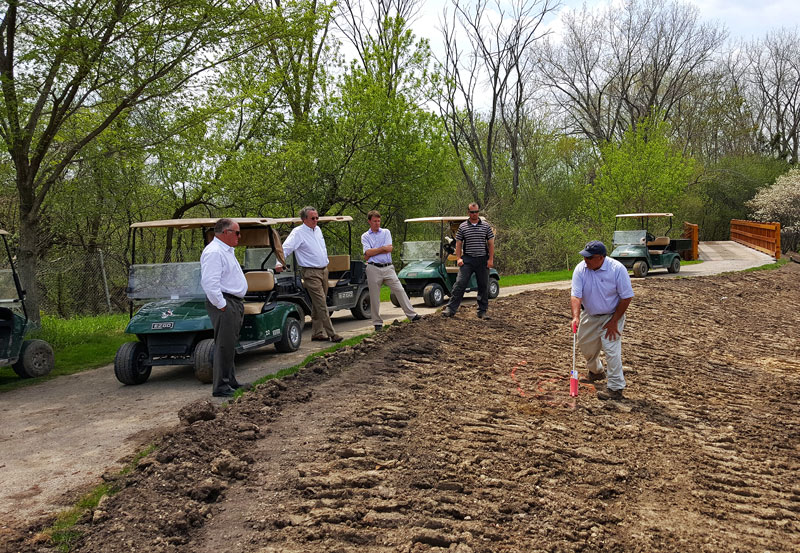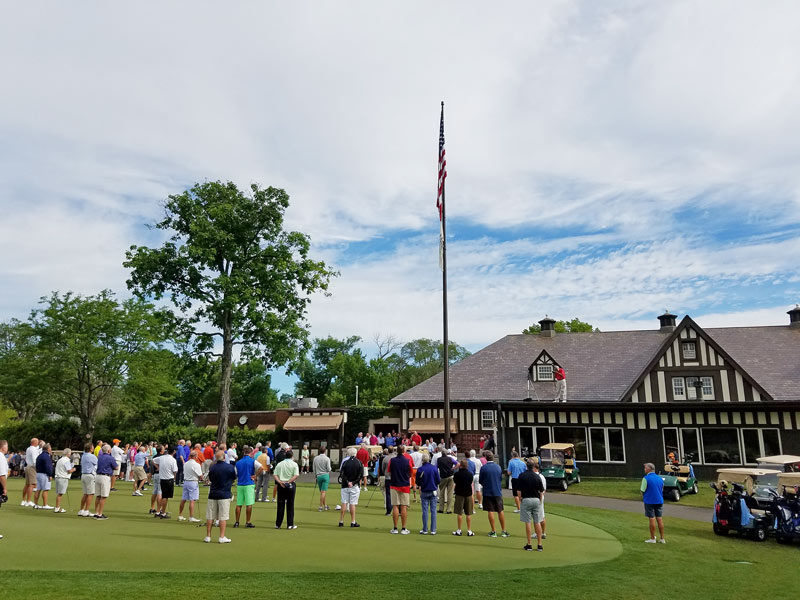
The 100-year-old Bob O’Link Golf Club in Highland Park, Ill., reopened in June following a major renovation that touched greens, tees, fairways, bunkers and the course’s irrigation system. Photos courtesy of Scott Pavalko
As golf course superintendents, we’re constantly trying to make the worlds of science and art coexist, blending the science of plant physiology with the art of presenting a living ecosystem — one that’s not only visually appealing, but that also meets standards of playability. The prospect of a comprehensive course redesign unfolding in the midst of all that may seem daunting, and the idea of a golf course architect — even one of the most respected — commandeering your course for a year or two and emerging with all new features may be unsettling, to say the least.
Your course may not undergo a total overhaul like we did here at Bob O’Link Golf Club in Highland Park, Ill., but with the vast majority of golf course architects focusing not on original designs but on redesign/rehabilitation projects, you’ll likely be faced with similar circumstances at some point in your career. When you are, you may wonder: What will my role be? Will the architect be considerate of maintenance needs? In the unavoidable conflicts between the art of course design and the science of growing turf, who will prevail? Will the timeline proposed by club leadership or the architect be realistic? Can something so weather-dependent and involving so many stakeholders be completed in one growing season, even in somewhere like the Great Lakes region?
I’m here to offer a glimpse into what has been both the most challenging and most rewarding experience of my career, in the hope that I can help prepare and embolden other superintendents to be their best when the time comes for a renovation or other large-scale project.
A classic course in crisis
Before being hired at Bob O’Link, I’d spent eight years at Muirfield Village Golf Club in Dublin, Ohio, three of them as assistant superintendent. As host site of the Memorial Tournament, the course was a global showcase not only for our work, but also for tournament founder and host Jack Nicklaus. Simply put: Perfection was expected. After Muirfield, I spent three years as director of grounds operations at Cog Hill Golf & Country Club in Lemont, Ill., which has hosted the Western Open, the U.S. Amateur and the BMW Championship. But despite having prepared courses for the best players and most demanding owners in the game, when I arrived at Bob O’Link, I wasn’t prepared for the unforeseen challenges that lay ahead.
The original Bob O’Link course, designed by Donald Ross on a cramped, 125-acre parcel of land, was completed in 1916. It had existed for less than a decade when, in June 1923, the club acquired 36 additional acres west of a nearby drainage canal. A new, more expansive 18-hole course was routed and designed, this time by legendary British golf course architect Charles Hugh Alison, who only practiced in the U.S. for a short time. The Alison course opened on July 4, 1925, and has remained a Chicagoland icon ever since.
Situated in the Skokie River flood plain, Bob O’Link’s course long struggled with drainage. Throughout its history, the course was modified several times by several architects, superintendents and boards of directors. The alterations repeatedly changed the face of the course but never fully dealt with the underlying drainage and flooding problems.
By 2014, these issues were severely impacting play. The aging drainage system coupled with the more than 20-year-old irrigation system wasn’t conducive to firm, fast conditions. Because of the outmoded irrigation system, watering the rough separately from the fairways wasn’t possible, which caused either overwatered fairways or under-watered rough. Years of washouts and floods had rendered the bunkers at best inconsistent and at worst unplayable. Throughout the decades, many trees had been planted on the course with the good intention of replacing dead or dying American elms, but the new trees’ massive canopies were now stifling turf growth. All of these factors had compromised or even nullified the original Alison vision.
Devising a revival
I remember saying during my interview for the job at Bob O’Link in February 2014 that I just wanted to grow as much healthy grass as I could my first year, and at the same time assess the course’s infrastructure. The notion of a substantial rehabilitation project wasn’t even on the table then. A few weeks later, however, after I’d been hired as director of agronomy, we removed the protective winter covers from the greens to examine the surfaces, and what we found wasn’t good. Like many Midwestern courses with Poa annua, Bob O’Link suffered significant winterkill on greens, tees and fairways during the harsh winter of 2013-2014. We experienced up to 80 percent turf loss on six of our 18 greens, and all 18 had been damaged. I notified club leadership of the bad news: It would likely be June before we could support play, and, even then, putting conditions would probably be very poor.
The board of directors had begun looking into addressing the root causes of the course’s conditioning problems back in 2013, but now, facing the reality that the greens needed serious attention, the time had come for a broader solution.
The club took bold action, announcing in spring 2015 a sweeping, $10 million overhaul dubbed the “Centennial Initiative.” The effort would encompass improved drainage, new irrigation, new subsurfaces for the greens, new turf throughout, a tree management regimen, and the restoration of Alison’s trademark green complexes. Board president Joe Valenti described the end goal as “An exciting golf course relevant to the modern game and sympathetic to the genius of Charles H. Alison.”
The scheduled completion date: early summer 2016.
In order for such a massive undertaking to be finished on such a tight deadline, the membership would have to sacrifice a full golf season in the summer-starved Midwest. It was one of the biggest decisions the membership had ever had to make, and although there was some pushback, members overwhelmingly bought in. Club leadership doubled down, enlisting a team that included irrigation consultant Mike Kuhn, golf construction consultant Tom Shapland, engineering consultant Christopher B. Burke Engineering Ltd., and irrigation contractor and golf course builder Leibold Irrigation.
For the design work and restoration of the superb Alison green complexes, the club hired Jim Urbina Golf Design. Jim, who in 2010 was named Co-Golf Architect of the Year (along with Tom Doak) by Golf Magazine, co-designed the acclaimed Old Macdonald course at Bandon Dunes, and was behind recent restorations at Pasatiempo Golf Club in Santa Cruz, Calif., and Garden City (N.Y.) Golf Club. He’s also done standout work at San Francisco Golf Club and Yeamans Hall Club in Charleston, S.C. For Bob O’Link, Urbina was charged with bringing back the distinctive and strategic elegance of the original Alison design.
In a move that may have been a courtesy but proved to be vital — and a move I would encourage any club considering a project of this sort to replicate — the club included me in the interview process for hiring an architect. As part of that process, I gave tours of the course to each candidate, which allowed me to see the course through the different designers’ points of view, and to get an idea of their work styles and personalities. This approach also made clear to the candidates that the superintendent would play a major — not marginal — role in the project.
Cool, calm, collaborative
Jim began by asking a lot of questions. I got the sense that he wanted, respected and valued my opinion, and during much of his time on-site (which was considerable), I accompanied him. In order to foster trust, and to finish the project on time, Jim and I were in constant communication. If we weren’t meeting face to face, we were emailing, calling or texting each other. We strived to keep our discussions open and honest — another key to the success of the project. Early on, I’d been concerned that decisions that might affect maintenance would be made without my input, but with Jim, that was never the case. I was never surprised, circumvented or undermined.

Golf course architect Jim Urbina uses paint to map out new bunkering on Bob O’Link’s fifth hole for (from left) club president Joe Valenti, treasurer William Andrews, head golf professional Dan Watters, and superintendent Matt Leinen.
A project the scale of the Bob O’Link Centennial Initiative requires the involvement of several professionals — architect, shaper, course builder, irrigation contractor, drainage contractor and more — and, because of that, the interaction of several different personalities. Each contributor has a valuable perspective, but no one likely cares as much about the finished course as the superintendent. After all the bulldozers and dump trucks are gone and the opening-day party is but a hazy memory, the superintendent is the one responsible for the quality of playing conditions day in, day out.
There were inevitable rubs, but I resolved early on that my job and the job of our agronomy staff would be to iron out conflicts, not create them. For example, the subject of grassing lines was a continual debate. For the most part, Jim and I were on the same page. I understood what he was trying to achieve with respect to playability, and he understood how grassing would affect our maintenance practices. In almost all cases, Jim deferred to me, but together we pushed the limits of what we thought we could accomplish with bentgrass.
Drainage was also an ongoing discussion, specifically the grading necessary to facilitate proper surface drainage. We’d been given a very explicit directive from membership to improve the course’s drainage. In fact, when Mr. Valenti and green committee chairman Joe Burden had pitched the Centennial Initiative to the membership, better drainage was one of the main selling points. The club had also hired consultant Tom Shapland to help manage the project and give input on drainage. Jim would have probably preferred not to perform any grading at all, thus preserving the historic purity of the fairways. Tom, however, was very much in favor of some fairly significant grading to ensure members’ expectations were met. In the end, we all discussed each point of view and came to a resolution that for the most part met Jim’s standards for aesthetics yet markedly improved surface drainage.
Another must during such an extensive renovation is regular construction meetings. This was Mr. Valenti’s idea. He’s in the construction business, and although his background isn’t specifically in golf course construction, he knew that keeping the entire team on the same page throughout every step of such a complicated process would be imperative. I oversaw the weekly meetings, during which we discussed, as a team, progress, problems and any deviations from the original plan and schedule.
Such discussions are especially crucial if you have a target seeding date. We knew we wanted to have all the greens seeded by the end of August 2015. If, for example, we’d realized in June that we were a week behind, we would have had plenty of time to make up for it. If such a realization didn’t come until July, however, there simply wouldn’t be enough time to react. The seed date would have to be pushed back, substantially delaying the whole project. (I’m happy to report that we seeded our last green on Aug. 23, 2015.)
Member-minded
The Centennial Initiative’s impact on the Bob O’Link membership was significant, with the course closed for virtually all of 2015, so to soften the blow, the club was extremely proactive in keeping members updated on the progress. We frequently shared drone footage of the project with our members online and via email. Members were also invited on regularly scheduled tours as the reconstruction advanced. Keeping the membership informed and enthused was essential, and it also allowed the entire Centennial Initiative team to work without added pressure.
Another tip: Expect the unexpected — you never know what you might find, particularly if you’re renovating a century-old golf course. We unearthed several generations of irrigation and drainage pipe, and we also discovered a few unique pieces of Bob O’Link history, including a horseshoe that may have been from the construction of the original course.

Members gather outside the Bob O’Link clubhouse for the course’s grand reopening in June 2016.
The Centennial Initiative has turned the page to a spectacular new chapter in Bob O’Link’s history. On June 14, we opened Jim Urbina’s renovation of the Alison design. The renovated course has been well received by the members. As I write this, we are in the middle of our largest member/guest tournament, and participants are enjoying competing on the restored course. Although we still have a few areas that aren’t perfect, our infrastructure upgrades coupled with the new grasses encourage much firmer and faster conditions from tee to fairway to green.
I must note here that the Centennial Initiative wouldn’t have come together nearly as smoothly without the dedication and hard work of the Bob O’Link agronomy staff. They deserve a huge share of the credit for the project’s success. A special thanks goes to superintendent Matt Leinen and assistant superintendent Matt Giermak, who each accepted a great deal of responsibility and certainly made my job easier.
As superintendents, we literally and figuratively want to protect our turf. Through the Bob O’Link Centennial Initiative, I was forced to see the golf course from more varied perspectives — through the eyes of our club leadership, the membership and our contractors, as well as through the expert eyes of a golf course architect. I liked what I saw, and I think our members will too.
Elements of the Bob O’Link renovation
Replacing Poa annua with bentgrass on greens, tees and fairways has given us less uncertainty about course conditions coming out of winter, as bentgrass is more winter-hardy. The new turf, along with improved drainage and a new irrigation system, has fostered firmer, faster playing conditions while also requiring less water and pesticides. The removal of more than 700 trees and countless bushes and shrubs has created a more open, far cleaner look.
Greens
- Hired the company GreenScan3D to scan putting surfaces to allow for preservation of historic Charles Hugh Alison green contours
- Constructed USGA greens using a custom mix of 85 percent sand, 10 percent Profile and 5 percent compost
- Replaced Poa annua with Pure Distinction creeping bentgrass
Tees
- Lowered to surrounding grade to restore Alison’s intended sightlines
- Eliminated any unnecessary tee area
- Rebuilt with subsurface drainage and 6 inches of 7-2-1 mix
- Replaced Poa annua with Crystal BlueLinks creeping bentgrass
Fairways
-
Expanded to their original size (5 total acres added)
- Fairway grass runs directly into bunkers
- Improved surface drainage
- Replaced Poa annua with Crystal BlueLinks creeping bentgrass
- Sand topdressing program will be implemented to promote Alison/Urbina “ground game” strategy (2 to 4 inches of sand added throughout five years)
Bunkers
- Restored Alison’s original positioning, strategy and visual layering
- Improved construction with Better Billy Bunker and Pro/Angle sand
Irrigation system
-
New system’s design allows for watering bentgrass surfaces separately from watering the rough
- Installed well to replenish irrigation pond, which improved the reliability and the quality of our water source
Trees
- Removed 700-plus trees and countless bushes, shrubs and landscape beds
- All remaining trees were professionally pruned and limbed up to enhance views
of corridors and promote better air
movement
- Transplanted more than 40 trees to strategic locations and better growing conditions
Scott Pavalko is the director of agronomy at Bob O’Link Golf Club in Highland Park, Ill. A native of Youngstown, Ohio, Scott is the son of the late Bob Pavalko, a former superintendent and GCSAA member. Scott graduated from Ohio State University in 2005 and is a 14-year member of GCSAA. He and his wife, Robin, live in Wilmette, Ill.